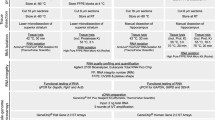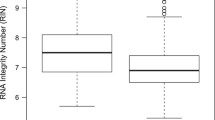Abstract
We present a novel approach for microarray analysis of RNA derived from microdissected cells of routinely formalin-fixed and paraffin-embedded (FFPE) cancer resection specimens. Subsequent to RNA sample preparation and hybridization to standard GeneChips (Affymetrix), RNA samples yielded 36.43 ± 9.60% (FFPE), 49.90 ± 4.43% (fresh-frozen), and 53.9% (cell line) present calls. Quality control parameters and Q-RT-PCR validation demonstrated reliability of results. Microarray datasets of FFPE samples were informative and comparable to those of fresh-frozen samples. A systematic measurement difference of differentially processed tissues was eliminated by a correction step for comparative unsupervised data analysis of fresh-frozen and FFPE samples. Within FFPE samples, unsupervised clustering analyses clearly distinguished between normal and malignant tissues as well as to further separate tumor samples according to histological World Health Organization (WHO) subtypes. In summary, our approach represents a major step towards integration of microarrays into retrospective studies and enables further investigation of the relevance of microarray analysis for clinico-pathological diagnostics.





Similar content being viewed by others
References
Hoheisel JD (2006) Microarray technology: beyond transcript profiling and genotype analysis. Nat Rev Genet 7:200–210
Sotiriou C, Piccart MJ (2007) Taking gene-expression profiling to the clinic: when will molecular signatures become relevant to patient care. Nat Rev Cancer 7:545–553
Brazma A, Hingamp P, Quackenbush J et al (2001) Minimum information about a microarray experiment (MIAME)-toward standards for microarray data. Nat Genet 29:365–371
MAQC ConsortiumShi L et al (2006) The MicroArray Quality Control (MAQC) project shows inter- and intraplatform reproducibility of gene expression measurements. Nat Biotechnol 24:1151–1161
Frueh FW (2006) Impact of microarray data quality on genomic data submissions to the FDA. Nat Biotechnol 24:1105–1107
Farragher SM, Tanney A, Kennedy RD et al (2008) RNA expression analysis from formalin fixed paraffin embedded tissues. Histochem Cell Biol 130:435–445
Vincek V, Nassiri M, Nadji M, Morales AR (2003) A tissue fixative that protects macromolecules (DNA, RNA, and protein) and histomorphology in clinical samples. Lab Invest 83:1427–1435
Specht K, Richter T, Müller U et al (2001) Quantitative gene expression analysis in microdissected archival formalin-fixed and paraffin-embedded tumor tissue. Am J Pathol 158:419–429
Antonov J, Goldstein DR, Oberli A et al (2005) Reliable gene expression measurements from degraded RNA by quantitative real-time PCR depend on short amplicons and a proper normalization. Lab Invest 85:1040–1050
Masuda N, Ohnishi T, Kawamoto S et al (1999) Analysis of chemical modification of RNA from formalin-fixed samples and optimization of molecular biology applications for such samples. Nucleic Acids Res 27:4436–4443
von Ahlfen S, Missel A, Bendrat K, Schlumpberger M (2007) Determinants of RNA quality from FFPE samples. PLoS ONE 2:e1261
Karsten SL, Van Deerlin VM, Sabatti C et al (2002) An evaluation of tyramide signal amplification and archived fixed and frozen tissue in microarray gene expression analysis. Nucleic Acids Res 30:E4
Xiang CC, Chen M, Ma L et al (2003) A new strategy to amplify degraded RNA from small tissue samples for microarray studies. Nucleic Acids Res 31:e53
Loudig O, Milova E, Brandwein-Gensler M et al (2007) Molecular restoration of archived transcriptional profiles by complementary-template reverse-transcription (CT-RT). Nucleic Acids Res 35:e94
Chen J, Byrne GE Jr, Lossos IS (2007) Optimization of RNA extraction from formalin-fixed, paraffin-embedded lymphoid tissues. Diagn Mol Pathol 16:61–72
Bibikova M, Talantov D, Chudin E et al (2004) Quantitative gene expression profiling in formalin-fixed, paraffin-embedded tissues using universal bead arrays. Am J Pathol 165:1799–1807
Bibikova M, Yeakley JM, Wang-Rodriguez J, Fan JB (2008) Quantitative expression profiling of RNA from formalin-fixed, paraffin-embedded tissues using randomly assembled bead arrays. Methods Mol Biol 439:159–177
Ravo M, Mutarelli M, Ferraro L et al (2008) Quantitative expression profiling of highly degraded RNA from formalin-fixed, paraffin-embedded breast tumor biopsies by oligonucleotide microarrays. Lab Invest 88:430–440
Lee J, Hever A, Willhite D, Zlotnik A, Hevezi P (2005) Effects of RNA degradation on gene expression analysis of human postmortem tissues. FASEB J 19:1356–1358
Scicchitano MS, Dalmas DA, Bertiaux MA et al (2006) Preliminary comparison of quantity, quality, and microarray performance of RNA extracted from formalin-fixed, paraffin-embedded, and unfixed frozen tissue samples. J Histochem Cytochem 54:1229–1237
Coudry RA, Meireles SI, Stoyanova R et al (2007) Successful application of microarray technology to microdissected formalin-fixed, paraffin-embedded tissue. J Mol Diagn 9:70–79
Penland SK, Keku TO, Torrice C et al (2007) RNA expression analysis of formalin-fixed paraffin-embedded tumors. Lab Invest 87:383–391
Frank M, Döring C, Metzler D, Eckerle S, Hansmann ML (2007) Global gene expression profiling of formalin-fixed paraffin-embedded tumor samples: a comparison to snap-frozen material using oligonucleotide microarrays. Virchows Arch 450:699–711
Haque T, Faury D, Albrecht S et al (2007) Gene expression profiling from formalin-fixed paraffin-embedded tumors of pediatric glioblastoma. Clin Cancer Res 13:6284–6292
Lauss M, Vierlinger K, Weinhaeusel A et al (2007) Comparison of RNA amplification techniques meeting the demands for the expression profiling of clinical cancer samples. Virchows Arch 451:1019–1029
Linton KM, Hey Y, Saunders E et al (2008) Acquisition of biologically relevant gene expression data by Affymetrix microarray analysis of archival formalin-fixed paraffin-embedded tumours. Br J Cancer 98:1403–1414
Srivastava PK, Küffer S, Brors B et al (2008) A cut-off based approach for gene expression analysis of formalin-fixed and paraffin-embedded tissue samples. Genomics. 91:522–529
Sobin LH, Wittekind C (2002) TNM classification of malignant tumours. UICC, 6th edn. Wiley Liss, Wilmington
Hamilton S, Aaltonen L (2000) Pathology and genetics of tumors of the digestive system. WHO classification of tumors. IARC, Lyon
Gerlach U, Kayser G, Walch A et al (2006) Centrosome-, chromosomal-passenger- and cell-cycle-associated mRNAs are differentially regulated in the development of sporadic colorectal cancer. J Pathol 208:462–472
Lassmann S, Weis R, Makowiec F (2007) Array CGH identifies distinct DNA copy number profiles of oncogenes and tumor suppressor genes in chromosomal- and microsatellite-unstable sporadic colorectal carcinomas. J Mol Med 85:293–304
Novoradovskaya N, Whitfield ML, Basehore LS et al (2004) Universal reference RNA as a standard for microarray experiments. BMC Genomics 5:20
Lassmann S, Schuster I, Walch A et al (2007) STAT3 mRNA and protein expression in colorectal cancer: effects on STAT3-inducible targets linked to cell survival and proliferation. J Clin Pathol 60:173–179
Lassmann S, Tang L, Capanu M et al (2007) Predictive molecular markers for colorectal cancer patients with resected liver metastasis and adjuvant chemotherapy. Gastroenterology 133:1831–1839
Schroeder A, Mueller O, Stocker S et al (2006) The RIN: an RNA integrity number for assigning integrity values to RNA measurements. BMC Mol Biol 7:3
Wu Z, Irizarry RA, Gentleman R, Martinez-Murillo F, Spencer F (2004) A model-based background adjustment for oligonucleotide expression arrays. J Am Stat Assoc 99:909–917
Wilson CL, Miller CJ (2005) Simpleaffy: a BioConductor package for Affymetrix quality control and data analysis. Bioinformatics 21:3683–3685
Benjamini Y, Hochberg Y (1995) Controlling the false discovery rate: a practical and powerful approach to multiple testing. J Roy Stat Soc B 57:289–300
de Kok JB, Roelofs RW, Giesendorf BA et al (2005) Normalization of gene expression measurements in tumor tissues: comparison of 13 endogenous control genes. Lab Invest 85:154–159
Lassmann S, Shen Y, Jütting U et al (2007) Predictive value of Aurora-A/STK15 expression for late stage epithelial ovarian cancer patients treated by adjuvant chemotherapy. Clin Cancer Res 13:4083–4091
Irizarry RA, Bolstad BM, Collin F et al (2003) Summaries of Affymetrix GeneChip probe level data. Nucleic Acids Res 31:e15
Wiese AH, Auer J, Lassmann S et al (2007) Identification of gene signatures for invasive colorectal tumor cells. Cancer Detect Prev 31:282–295
Kerkhoven RM, Sie D, Nieuwland M et al (2008) The T7-primer is a source of experimental bias and introduces variability between microarray platforms. PLoS ONE 3:e1980
Ma C, Lyons-Weiler M, Liang W et al (2006) In vitro transcription amplification and labeling methods contribute to the variability of gene expression profiling with DNA microarrays. J Mol Diagn 8:183–192
Chi JT, Wang Z, Nuyten DS et al (2006) Gene expression programs in response to hypoxia: cell type specificity and prognostic significance in human cancers. PLoS Med 3(3):e47
Zhang H, Semenza GL (2008) The expanding universe of hypoxia. J Mol Med 86(7):739–746
Michael-Robinson JM, Reid LE, Purdie DM et al (2001) Proliferation, apoptosis, and survival in high-level microsatellite instability sporadic colorectal cancer. Clin Cancer Res 7:2347–2356
Acknowledgements
The study would not have been possible without the long-term substantial research support to SL and MW by the Mushett Family Foundation, Chester, NJ, USA. The study has been funded in parts (in vitro experiments) by a grant to SL and MW from the German Research Foundation (DFG). SL and MW also acknowledge their collaborators Drs. Laura Tang and David Klimstra at the Memorial Sloan Kettering Cancer Center, New York. CK and JT acknowledge financial support by the BMBF-grant 0313921 FRIYSY.
Author information
Authors and Affiliations
Corresponding author
Electronic supplementary material
Below is the link to the electronic supplementary material.
ESM
(PDF 173 KB)
Supplementary Table 1
(PDF 97.1 KB)
Rights and permissions
About this article
Cite this article
Lassmann, S., Kreutz, C., Schoepflin, A. et al. A novel approach for reliable microarray analysis of microdissected tumor cells from formalin-fixed and paraffin-embedded colorectal cancer resection specimens. J Mol Med 87, 211–224 (2009). https://doi.org/10.1007/s00109-008-0419-y
Received:
Revised:
Accepted:
Published:
Issue Date:
DOI: https://doi.org/10.1007/s00109-008-0419-y




